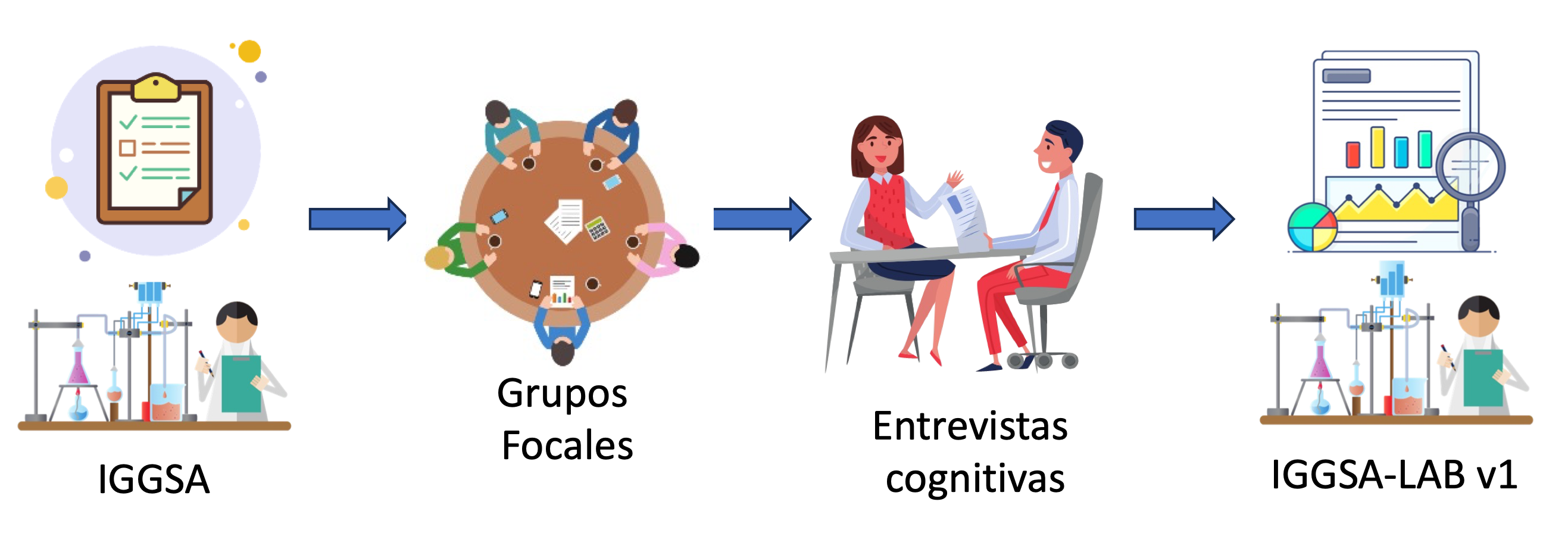Validation of an instrument to evaluate the integral management of safety in academic laboratories
Main Article Content
Abstract
Safety in academic laboratories is a significant area of interest due to the different risk factors presented that expose laboratory staff as well as increase the likelihood of accidents. Through 111 items grouped into 4 dimensions, the original IGSSA instrument was proposed to comprehensively evaluate safety and health management along with civil and environmental protection in sciences laboratories at high schools. This study aimed to validate the IGSSA instrument to facilitate that teachers can conduct inspections to evaluate safety regulatory compliance in their science laboratories. The questionnaire content validation methodology included focus groups with representatives of regulatory agencies and cognitive interviews with laboratory teachers. The final IGSSA-LAB v1 instrument comprises a combined indicator, clustering 85 items into 7 dimensions. The instrument has a participatory approach since the inspection should be conducted by the laboratory teachers supporting the compliance with existing regulation. Additionally, it enhances knowledges and strengthens the safety culture and environment protection in high schools.
Article Details
Citas en Dimensions Service
References
ACS. (2012). ACS Guidelines and Recommendations for teaching middle and high school chemistry, consultada en febrero 1, 2022, en la URL https://www.acs.org/content/dam/acsorg/education/policies/recommendations-for-the-teaching-of-high-school-chemistry.pdf
ACS. (2017). Safety in Academic Chemistry Laboratories. (8th ed.). American Chemical Society, consultada en Febrero 1, 2022, en la URL https://www.acs.org/content/dam/acsorg/about/governance/committees/chemicalsafety/publications/safety-in-academic-chemistry-laboratories-students.pdf
Álvarez-Chávez, C.R., Arce-Corrales, M.E., Castañeda-Quesney, M.F., Duarte-Tagles, H.F., Esquer-Manríquez, R., Flores-Soto, A.A., Muñoz-Osuna, F. O. (2018). Diplomado en salud, seguridad y protección al ambiente en laboratorios de ciencias de educación media superior. (Octubre 7 de 2017 a Mayo 19 de 2018). Programa de Educación Continua de la Universidad de Sonora.
Alvarez-Chavez, C. R., Flores-Soto, A. A., Arce-Corrales, M. E., Esquer-Peralta, J., y Munguía-Vega, N. E. (2021). Tool for the Integrated Assessment of Health, Safety, Civil, and Environmental Protection Management in High School Laboratories (IHSCE Tool). ACS Chemical Health y Safety, 28(4), 279–289. https://doi.org/10.1021/acs.chas.0c00110
Asiry, S., y Ang, L.-C. (2019). Laboratory Safety: Chemical and Physical Hazards (Vol. 1897, pp. 243–252). Humana Press. https://doi.org/10.1007/978-1-4939-8935-5_21
Ayi, H.-R., y Hon, C.-Y. (2018). Safety culture and safety compliance in academic laboratories: A Canadian perspective. Journal of Chemical Health and Safety, 25(6), 6–12. https://doi.org/10.1016/j.jchas.2018.05.002
Blancas-Vergara, F. García-Reyes, F., López-Escobedo, J. R. (2019). Accidentes por substancias peligrosas en los laboratorios escolares ¿prevención obligatoria ó descuido laboral? In Prevención Integral. ORP 19 Congreso Internacional, consultada en febrero 1, 2022. https://www.prevencionintegral.com/canal-orp/papers/orp-2019/accidentes-por-substancias-peligrosas-en-laboratorios-escolares-prevencion-obligatoria-o-descuido
Cluster Minero de Sonora, A. C. (2017). Toma de Protesta del Comité Consultivo en Materiales Peligrosos del Estado de Sonora, consultada en febrero 1, 2022, en la URL https://fb.watch/aVyUNio6-1/
El Sol de México. (2018). Sale mal experimento de química en CETIS de Coahuila, explosión deja 10 heridos. Nota Periodística, consultada en febrero 1, 2022, en la URL https://www.elsoldemexico.com.mx/doble-via/virales/cetis-coahuila-experimento-de-quimica-acido-1959014.html
Fivizzani, K. P. (2016). Where are we with lab safety education: Who, what, when, where, and how? Journal of Chemical Health y Safety, 23(5), 18–20. https://doi.org/10.1016/j.jchas.2015.11.001
HSA. (2018). Guidelines on managing safety, health and welfare in Post-primary schools. Revised guidelines. Health and Safety Authority, consultada en febrero 1, 2022, en la URL https://www.hsa.ie/eng/education/managing_safety_and_health_in_schools/new_guidelines_files/spp-part-a-b-c-interactive-f.pdf
Hamui-Sutton, A. y Varela-Ruiz, M. (2013). La técnica de grupos focales. Investigación en educación médica. 2(1), 55-60.
INIFED-SEP. (2014). Normas y Especificaciones, para estudios, prouectos, construcción e instalaciones. Volumen 3. Habitabilidad y Funcionamiento. Tomo II. Norma de accesibilidad, consultada en Enero 31, 2022, en la URL http://www.educacionespecial.sep.gob.mx/pdf/doctos/4Accesibilidad/1Normas_especificaciones_INIFED.pdf
Kaufman J.A. (2020). Killed in lab accidents: Memorial wall. Laboratory Safety Institute, consultada en Enero 29, 2022, en la URL https://www.labsafety.org/memorial-wall
Marin, L. S., Muñoz-Osuna, F. O., Arvayo-Mata, K. L., y Álvarez-Chávez, C. R. (2019). Chemistry laboratory safety climate survey (CLASS): A tool for measuring students’ perceptions of safety. Journal of Chemical Health y Safety, 26(6), 3–11. https://doi.org/10.1016/j.jchas.2019.01.001
Ménard, A. D., y Trant, J. F. (2020). A review and critique of academic lab safety research. Nature Chemistry, 12(1), 17–25. https://doi.org/10.1038/s41557-019-0375-x
NRC. (2014). Safe Science: Promoting a Culture of Safety in Academic Chemical Research. National Academies Press. https://doi.org/https://doi.org/10.17226/18706
NSTA. (2015). An NSTA Position Statement: Safety and School Science Instruction, consultada en Diciembre 20, 2020, en la URL https://static.nsta.org/pdfs/PositionStatement_Safety.pdf
Olewski, T., y Snakard, M. (2017). Challenges in applying process safety management at university laboratories. Journal of Loss Prevention in the Process Industries, 49, 209–214. https://doi.org/10.1016/j.jlp.2017.06.013
Schenk, L., Taher, I. A., y Öberg, M. (2018). Identifying the Scope of Safety Issues and Challenges to Safety Management in Swedish Middle School and High School Chemistry Education. Journal of Chemical Education, 95(7), 1132–1139. https://doi.org/10.1021/acs.jchemed.8b00054
SinEmbargo. (2016). Explosión durante práctica en laboratorio de la UAM Xochimilco deja 19 personas lesionadas, consultada en Febrero 1, 2022, en la URL https://www.sinembargo.mx/17-02-2016/1624885
Uno TV. (2017). Accidente de laboratorio deja 16 alumnos lesionados en Tlaxcala, consultada en Febrero 1, 2022, en la URL https://www.unotv.com/noticias/estados/tlaxcala/detalle/accidente-laboratorio-deja-16-alumnos-heridos-tlaxcala-132627/
Walters, A. U. C., Lawrence, W., y Jalsa, N. K. (2017). Chemical laboratory safety awareness, attitudes and practices of tertiary students. Safety Science, 96, 161–171. https://doi.org/10.1016/j.ssci.2017.03.017
Willis, G. B. (1999). Cognitive Interviewing A “How To” Guide”, consultada en Diciembre 20, 2021, en la URL https://www.hkr.se/contentassets/9ed7b1b3997e4bf4baa8d4eceed5cd87/gordonwillis.pdf
Willis, G. B. (2005). Cognitive interviewing. SAGE Publications, Inc., https://dx.doi.org/10.4135/9781412983655

Educación Química por Universidad Nacional Autónoma de México se distribuye bajo una Licencia Creative Commons Atribución-NoComercial-SinDerivar 4.0 Internacional.
Basada en una obra en http://www.revistas.unam.mx/index.php/req.
